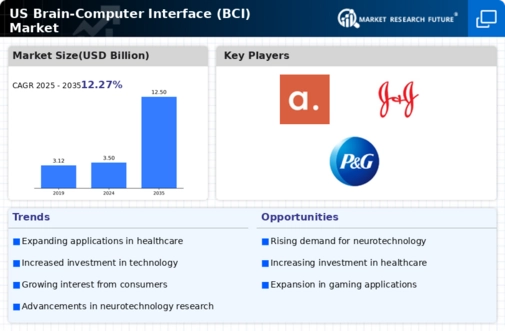US Brain Computer Interface Market Summary
The US Brain-Computer Interface market is projected to grow significantly from 3.5 USD Billion in 2024 to 12.5 USD Billion by 2035.
Key Market Trends & Highlights
US Brain-Computer Interface (BCI) Key Trends and Highlights
- The market is expected to experience a compound annual growth rate of 12.27 percent from 2025 to 2035.
- By 2035, the market valuation is anticipated to reach 12.5 USD Billion, indicating robust growth potential.
- In 2024, the market is valued at 3.5 USD Billion, reflecting the current investment landscape in BCI technology.
- Growing adoption of Brain-Computer Interface technology due to increasing demand for advanced neurotechnology solutions is a major market driver.
Market Size & Forecast
| 2024 Market Size | 3.5 (USD Billion) |
| 2035 Market Size | 12.5 (USD Billion) |
| CAGR (2025 - 2035) | 12.27% |
Major Players
Apple Inc (US), Microsoft Corp (US), Amazon.com Inc (US), Alphabet Inc (US), Berkshire Hathaway Inc (US), Meta Platforms Inc (US), Tesla Inc (US), Johnson & Johnson (US), Visa Inc (US), Procter & Gamble Co (US)














Leave a Comment